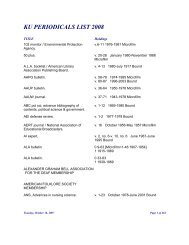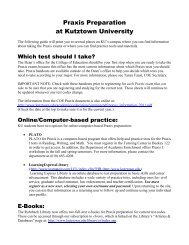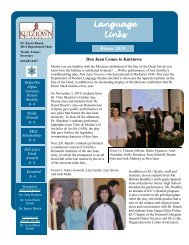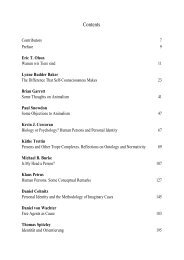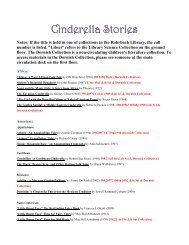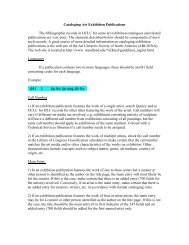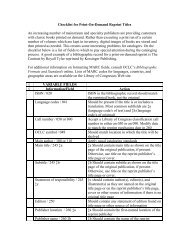Deep-tow magnetic anomaly study of the Pacific Jurassic Quiet Zone ...
Deep-tow magnetic anomaly study of the Pacific Jurassic Quiet Zone ...
Deep-tow magnetic anomaly study of the Pacific Jurassic Quiet Zone ...
You also want an ePaper? Increase the reach of your titles
YUMPU automatically turns print PDFs into web optimized ePapers that Google loves.
B07110<br />
TOMINAGA ET AL.: JURASSIC QUIET ZONE MAGNETIC ANOMALIES<br />
B07110<br />
on ano<strong>the</strong>r line, <strong>the</strong> multiple blocks were merged and<br />
modeled as one polarity period in <strong>the</strong> composite model.<br />
This procedure minimizes <strong>the</strong> number <strong>of</strong> modeled polarity<br />
blocks.<br />
2.5. Age Calibration<br />
[20] Mesozoic <strong>magnetic</strong> anomalies have only a few good<br />
absolute age calibration points with which to interpolate or<br />
extrapolate <strong>the</strong> ages <strong>of</strong> chron boundaries. Sager et al. [1998]<br />
used <strong>the</strong> radiometric date <strong>of</strong> M26r (155.3 ± 3.4 Ma) from<br />
<strong>the</strong> Argo Abyssal plain [Ludden, 1992] to tie <strong>the</strong> 1992 deep<strong>tow</strong><br />
lines to that <strong>anomaly</strong> in Pigafetta Basin. They extrapolated<br />
<strong>the</strong> ages <strong>of</strong> blocks from M25 backward in time using<br />
<strong>the</strong> existing GPTS at <strong>the</strong> time [e.g., Gradstein et al., 1995;<br />
Handschumacher et al., 1988]. Our approach was to use <strong>the</strong><br />
absolute age for M26r and a new high-precision age<br />
determination for <strong>the</strong> tholeiitic basalt layer in Hole 801C<br />
(167.4 ± 1.7 Ma) [Koppers et al., 2003a] as tie points on<br />
both ends <strong>of</strong> <strong>the</strong> survey lines, with linear interpolation in<br />
between, assuming a constant spreading rate. The interpolation<br />
used <strong>the</strong> following age-distance relation:<br />
AgeðMaÞ ¼0:0146 distanceðkmÞþ155:3Ma;<br />
Figure 6.<br />
(continued)<br />
<strong>of</strong> magnetization values calculated by inverse modeling.<br />
Although Sager et al. [1998] applied an exponential reduction<br />
in <strong>the</strong> magnetization strength with an initial magnetization<br />
<strong>of</strong> 2.25 Am 1 , we did not find this model to be an<br />
especially good approximation for <strong>the</strong> new data. For our<br />
analysis, <strong>anomaly</strong> amplitudes were adequately approximated<br />
with a constant magnetization in each <strong>of</strong> <strong>the</strong> <strong>study</strong> areas.<br />
The magnetization values used in this <strong>study</strong> are as follows:<br />
3.9 Am 1 for M34, 1.7 Am 1 for H801C, 2.0 Am 1 for<br />
NORTH, and 2.3 Am 1 for SOUTH. These values provide<br />
<strong>the</strong> best match in terms <strong>of</strong> amplitude and shape between<br />
observed and calculated <strong>magnetic</strong> anomalies. The magnetizations<br />
for H801C, NORTH, and SOUTH are essentially<br />
<strong>the</strong> same. The M34 survey magnetization is nearly twice as<br />
high because <strong>the</strong> <strong>magnetic</strong> anomalies in that area have<br />
significantly larger amplitudes (Figures 2 and 3). A Gaussian<br />
filter (s = 7 km) was applied to <strong>the</strong> forward models to<br />
give finite-width reversal transitions, which give a better fit<br />
<strong>of</strong> observed and modeled <strong>anomaly</strong> slopes [Schouten and<br />
Denham, 1979].<br />
2.4. Composite Model<br />
[19] Once <strong>magnetic</strong> polarity block models were constructed<br />
for each survey line, a composite model was<br />
compiled from <strong>the</strong> overlapping lines (Figures 6 and 7.<br />
The purpose was to create a reversal sequence common to<br />
all lines within a given survey area. From <strong>the</strong> Sager et al.<br />
[1998] <strong>study</strong>, we adopted <strong>the</strong> composite model for <strong>the</strong> two<br />
previous deep-<strong>tow</strong> lines (92-1 and 92-2) as a starting point<br />
for <strong>the</strong> NORTH area where new and old data overlap. The<br />
boundary locations <strong>of</strong> each polarity block in <strong>the</strong> composite<br />
model were calculated by averaging values <strong>of</strong> corresponding<br />
block boundary distances. In <strong>the</strong> case <strong>of</strong> two or more<br />
polarity blocks on one line corresponding to only one block<br />
corresponding to a half spreading rate <strong>of</strong> 67 km/Ma<br />
(Figure S3). To make an age model for anomalies older and<br />
younger than <strong>the</strong> calibration points, we extrapolated this<br />
relation, using <strong>the</strong> polarity block model <strong>of</strong> Sager et al.<br />
[1998] for younger anomalies.<br />
[21] Error estimates for <strong>the</strong> two radiometric dates contribute<br />
an uncertainty in <strong>the</strong> modeled spreading rate. The<br />
minimum and maximum slopes that fit <strong>the</strong> 1-sigma uncertainty<br />
bounds on <strong>the</strong> radiometric ages are 51 km/Ma and<br />
98 km/Ma. Although such extreme slopes are possible given<br />
<strong>the</strong> calibration point uncertainties, <strong>the</strong> highest and lowest<br />
implied values are unlikely because <strong>the</strong>y quickly produce<br />
unreasonable ages when extrapolated outside <strong>the</strong> local survey<br />
region.<br />
3. Results<br />
3.1. Anomaly Correlation<br />
[22] What is ‘‘good’’ correlation? Naturally, this is subjective<br />
and what is considered good or acceptable correlation<br />
varies among analysts. To provide a quantitative<br />
foundation, we computed coherency (cross-correlation)<br />
among many <strong>of</strong> <strong>the</strong> deep-<strong>tow</strong> pr<strong>of</strong>iles and a comparison<br />
with established correlated sea surface anomalies (Figure 8).<br />
With ‘‘good’’ correlation, anomalies on adjacent pr<strong>of</strong>iles<br />
have similar shape and spacing. Such pr<strong>of</strong>iles have low-lag<br />
coherency values typically above 0.6 (e.g., GH824A<br />
versus GH7901 in Figure 8). Pr<strong>of</strong>iles with anomalies that<br />
show dissimilarities in <strong>anomaly</strong> size and shape (e.g.,<br />
GH824B versus GH7901 in Figure 8), typically have lowlag<br />
coherency values <strong>of</strong> less than 0.4. In our <strong>study</strong> area, <strong>the</strong><br />
between-line correlation <strong>of</strong> <strong>the</strong> deep-<strong>tow</strong> anomalies in our<br />
<strong>study</strong> is mostly excellent to good in all areas except for <strong>the</strong><br />
NORTH area. The best correlation was in <strong>the</strong> M34 survey<br />
where anomalies were closely matched on adjacent lines<br />
(Figure 3). In <strong>the</strong> M34 survey, <strong>anomaly</strong> amplitudes are<br />
relatively large (500 nT) and <strong>the</strong> anomalies show only<br />
small differences in <strong>anomaly</strong> shape and size between lines.<br />
9<strong>of</strong>20



